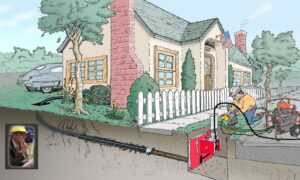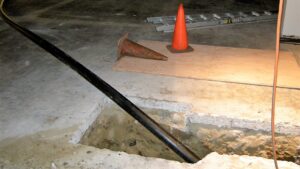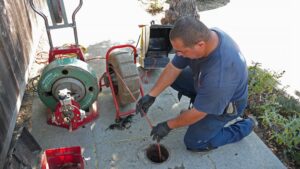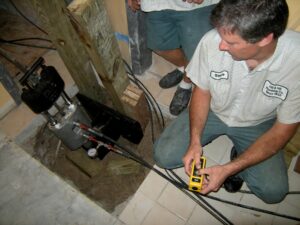
CodeNotes: Replacement of Underground Building Sewers and Building Drains in the I-Codes
This CodeNotes resource provides sustainable solutions involved in the replacement of underground building sewers and building drains.
This edition of CodeNotes — Replacement of Underground Building Sewers and Building Drains in the I-Codes — is based on Section 716 of the 2021 International Plumbing Code® and Section P3010 of the 2021 International Residential Code®
Introduction
The 2021 International Plumbing Code® (IPC®) provides sustainable solutions to assist building owners, designers, inspectors, municipalities, and contractors involved in the replacement of underground building sewers and building drains. Trenchless technology by pipe bursting typically yields the largest increase in hydraulic capacity of any of the trenchless sewer rehabilitation methods because other methods, such as lining the inside of the pipe, decrease the existing pipe’s inside diameter and thus, its capacity. Therefore, pipe bursting might be especially applicable to projects that require maintaining or increasing the size of the current pipe as well as replacing defective pipe. Because of the technology’s proven success in the replacement of building sewers, the IPC was updated in the 2018 edition to include the replacement of underground building drains. Pipe bursting as it is commonly referred to involves the replacement of an old sewer pipe with a new pipe, of the same or larger diameter, in a process that destroys the original pipe as the new one is installed. The pipe bursting tool, which is pulled through the sewer by a winch or rod, is located at an upstream opening, and forces its way through existing pipe materials by fragmenting the old pipe and compressing the broken pieces into the soil as it progresses from one end to the other.

History
In developed countries, many post-WWII utility lines are at the end of their service life, while at the same time a large percentage of the world’s population between one and two billion people have substandard sanitation and no regular source of clean drinking water.
In the United States, the topic of failing infrastructure has become a regular theme in the media. The problem is sanitary sewer overflows (SSOs), caused by inflow and infiltration, which occurs when groundwater and other surface drainage enter and inundate sanitary sewer systems. These terms and what they imply are steadily gaining awareness across America and around the world.

Rehabilitation and replacement of an aging sewer infrastructure with the least amount of impact on the consumer is important. This pipe replacement process utilizes HDPE (High-Density Polyethylene) seamless piping that is joint-free, preventing root intrusion. A sewer camera is used to do a video inspection to ensure that the pipe replacement was done correctly and that the proper grade (slope) of the pipe is obtained.

Code Requirements
Let’s take a closer look at section 716 of the IPC and section P3010 of the IRC and their requirements. Section 716.2 of the IPC and section P3010.2 of the IRC allows the replacement of building sewer pipe by pipe bursting methods to a maximum of six inches (152 mm) and smaller. The replacement piping must be of the same nominal size as the existing piping. Section 716.3 of the IPC and Section P 3010.3 of the IRC require that the existing piping sections that are to be replaced be inspected internally by a recorded video camera survey. The survey must include notations of the position of the cleanouts and the depth of the connections to the existing piping.

716.4 of the IPC and section P3010.4 of the IRC require the replacement piping to be of high-density polyethylene (HDPE) and must have a standard diameter ratio (SDR) of 17 in compliance with ASTM F 714. The pipe fittings to be connected to the replacement piping must be of extra high-density polyethylene (HDPE) and comply with ASTM D2683. Where the existing building sewer or building drain did not previously have cleanouts, the requirements of both codes will require cleanout fittings to be installed. The completed replacement piping section must be inspected internally by a recorded video camera survey and then be reviewed and approved by the code official prior to pressure testing of the replacement piping system. The test must be in accordance with section 312 of the IPC or section P2503.4 if using the IRC.

Summary
The requirements in Sections 716 of the IPC and P3010 of the IRC give contractors and engineers the necessary tools to do the job while being environmentally friendly. They support sustainability by reducing negative impacts on property and infrastructures and will eliminate costs associated with the replacement of landscaping, trees, driveways, sidewalks, patios and more. The environmental benefits of Trenchless Technology will be attractive to those jurisdictions that will be adopting the 2021 International Plumbing Code and/or the 2021 International Residential Code. Current research shows that CO2 emissions are reduced when trenchless methods are used versus open-cut. This translates to a direct-cost benefit for cities that are facing carbon taxation.
Yes, trenchless technology by pipe bursting saves time, money and minimizes restoration costs. The I-Codes remain the leader in providing sustainable solutions.
To order the 2021 IPC or IRC, Commentaries or other support references, visit here.








